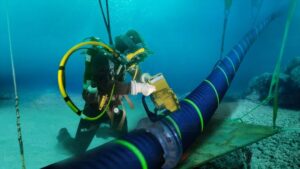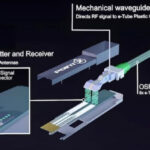Undersea cables — also known as submarine cables — are the backbone of global communication and power transmission. From carrying 99% of international internet traffic to connecting offshore wind farms to power grids, these cables are essential to modern life. But how exactly are they installed on the seabed?

how undersea cable is laid
This guide walks you through the entire undersea cable laying process, from planning to commissioning.
1. Route Planning and Seabed Survey
Before a single meter of cable is laid, engineers conduct extensive marine surveys:
Seabed mapping: Using sonar and remote operated vehicles (ROVs) to identify safe routes.
Hazard avoidance: Avoiding earthquake fault lines, coral reefs, shipwrecks, and fishing zones.
Route optimization: Choosing the shortest and safest path to minimize cost and risk.
📍 Fun fact: A single submarine cable route can take years to plan and may cover thousands of kilometers.
2. Cable Manufacturing and Testing
The undersea cable is specially designed for durability:
Core conductor: Copper or aluminum for power cables; optical fibers for data cables.
Insulation: Cross-linked polyethylene (XLPE) or similar materials.
Armoring: Steel wires for mechanical protection in shallow waters.
Sheathing: Polyethylene resistant to seawater and corrosion.
Before shipment, each cable section undergoes high-voltage, tensile, and pressure tests to ensure reliability under deep-sea conditions.
3. Loading the Cable onto Cable-Laying Ships
Massive cable-laying vessels are used, capable of carrying thousands of kilometers of submarine cable in huge rotating tanks.
Cable is coiled carefully to prevent tangling.
Onboard, advanced systems monitor cable tension during deployment.
The ship sets sail along the pre-planned route.
4. Cable Laying on the Seabed
The actual laying process varies depending on water depth:
Shallow Waters (Near Shore)
Cables are buried using ploughs or jetting machines, which cut a trench and cover the cable with seabed sediment.
Burial depth is typically 1–3 meters, protecting against fishing activity and anchors.
Deep Waters (Mid-Ocean)
Cables are usually laid directly on the seabed, since risks are lower.
Special machinery ensures controlled tension to avoid stretching or snapping.
The cable ship moves slowly (often less than 10 km/h) while precisely laying the cable.
5. Shore Landings
At each end of the route, cables must be brought ashore:
Divers, ROVs, or small boats pull the cable from ship to shore.
Cables are then connected to beach manholes, which link to terrestrial networks or substations.
Additional armoring and protection are applied near the shoreline, where risks are greatest.
6. Jointing and Testing
Since cables are manufactured in sections, underwater joints are required:
Highly specialized joints are made onboard, sealed against seawater and pressure.
Optical fibers are spliced with minimal signal loss.
Electrical cables undergo high-voltage tests to ensure no defects.
7. Commissioning and Monitoring
Once installed, the cable undergoes final inspections:
ROV inspections confirm correct burial and placement.
Continuous monitoring detects signal integrity (for data cables) or electrical load performance (for power cables).
Regular maintenance missions are scheduled to repair faults, usually caused by anchors or earthquakes.
Key Challenges in Undersea Cable Laying
Ocean depth: Some cables lie at depths over 8,000 meters.
Weather conditions: Storms can delay or complicate operations.
Geopolitical issues: Cables often cross multiple countries’ territorial waters.
Environmental protection: Routes must minimize impact on marine ecosystems.
Conclusion
Laying an undersea cable is a complex, multi-step engineering project that requires advanced vessels, precision technology, and years of planning. From the shallow coastal waters to the deep ocean floor, each step ensures that submarine cables can deliver reliable, long-term performance for global communications and power transmission.
Whether it’s internet fiber-optic trunk lines or extra high voltage submarine power cables, the laying process is a fascinating blend of marine science and engineering excellence.






1 comment
Vorbelutrioperbir 10/07/2025
Some times its a pain in the ass to read what people wrote but this site is rattling user pleasant! .